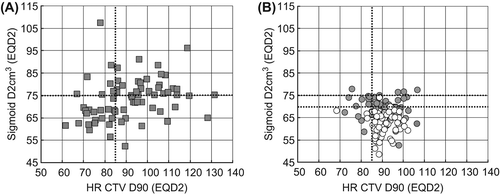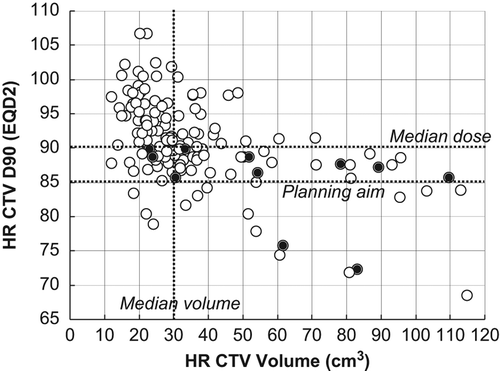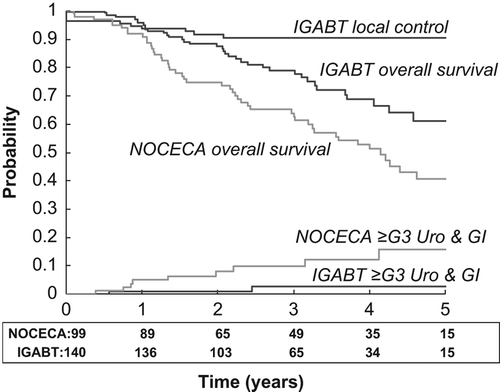Figures & data
Table II. Treatment characteristics for the IGABT and NOCEAC cohorts of patients with locally advanced cervical cancer treated at Aarhus University Hospital.
Table I. Patient and tumour characteristics for two cohorts treated with either MRI-guided IGABT or x-ray-based BT (NOCECA) at Aarhus University Hospital for locally advanced cervical cancer.
Figure 1. Cumulative dose (EQD2) of EBRT and IGABT in terms of D2 cm3 to the sigmoid plotted as a function of the D90 to the HR CTV. DVH parameters for a standard point A-based plan for the first 70 consecutive patients (2005–2008) is shown in panel A. Optimised DVH parameters actually used for treatment in all 140 patients are given in panel B divided into the first 70 patients treated 2005–2008 (grey circles) and the last 70 consecutive patients treated 2009–2011 (white circles). The planning aim of 85 Gy to D90 of HR CTV and the DVH constraints of first 75 and later 70 Gy are indicated by dotted lines.

Table III. DVH parameters for EBRT and BT calculated in EQD2 (mean, range) for 140 consecutive patients treated with IGABT in the period 2005–2011 at Aarhus University Hospital. The DVH parameters for the 70 first and 70 last consecutively treated patients are given in separate columns. In addition, standard point A-based DVH parameters are given for the first 70 patients treated 2005–2008. Number of patients fulfilling the planning aim (HR CTV D90 > 85 Gy, D2 cm3 bladder < 90 Gy and D2 cm3 rectum and sigmoid < 75 Gy) are also indicated.
Figure 2. D90 of HR CTV shown as a function of HR CTV volume in 140 consecutive patients treated with MRI-based IGABT for locally advanced cervical cancer. Local failure was observed in 11 patients (black spot). The planning aim for D90 of HR CTV and the median D90 and volume of HR CTV are indicated by dotted lines.

Figure 3. Actuarial local control, overall survival and ≥ grade 3 combined urological-gastrointestinal morbidity in 140 patients treated with IGABT (black lines). For comparison the curves for overall survival and morbidity in 99 patients treated with 2D x-ray-based brachytherapy (NOCECA) are indicated (grey lines). Patient number at risk for overall survival is indicated below the x-axis.

Table IV. Outcome in terms of actuarial three-year disease control, survival and morbidity in 140 consecutive patients treated with MRI-guided IGABT compared with 99 patients treated with x-ray-based BT (NOCECA).
